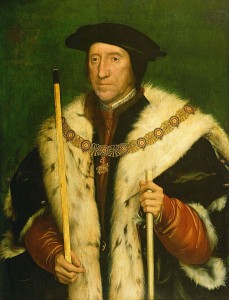
On 15th June 1536, Henry VIII sent members of his council, led by Thomas Howard, 3rd Duke of Norfolk, to visit his daughter, the Lady Mary, and bully her into accepting her father as supreme head of the Church in England and acknowledging that she was not the legitimate heir to the throne.
Eustace Chapuys, the imperial ambassador and a friend of Mary, recorded the visit of these bullies in a letter to the Emperor:
“To induce her to obey his commands and accede to his wishes, the King sent to her a deputation composed of the duke of Norfolk, the earl of Sussex (Robert Ratcliffe), the bishop of Chester (Roland Lee), and several others, whom she literally confounded by her very wise and prudent answers to their intimation. Upon which, finding that they could not persuade her, one of them said that since she was such an unnatural daughter as to disobey completely the King’s injunctions, he could hardly believe (said the interlocutor) that she was the King’s own bastard daughter. Were she his or any other man’s daughter, he would beat her to death, or strike her head against the wall until he made it as soft as a boiled apple; in short that she was a traitress, and would be punished as such. Many other threats of the same sort did the said deputies utter on the occasion, assisted in their task by the Princess’ governess, who happens to be the same as before, having then and there received orders not to allow the Princess to speak a word to any one, and to watch over her so that she should never be left alone by night or day.”
It must have been a scary encounter and it is little wonder that Chapuys, who must have been worried about Mary’s health and safety, encouraged her to make the “sacrifice” and submit to her father. Mary finally relented on 22nd June 1536*, signing her submission:
“The confession of me, the lady Mary, made upon certain points and articles under written, in the which, as I do now plainly and with all mine heart confess and declare mine inward sentence, belief, and judgment, with a due conformity of obedience to the laws of the realm; so minding for ever to persist and continue in this determination, without change, alteration, or variance, I do most humbly beseech the King’s Highness, my father, whom I have obstinately and inobediently offended in the denial of the same heretofore, to forgive mine offences therein, and to take me to his most gracious mercy.”
She went on to acknowledge the King as her sovereign and as Supreme Head of the Church of England, to repudiate the authority of the Pope and to acknowledge that her parents’ marriage had bee “by God’s law and man’s law incestuous and unlawful”.
*Mary’s submission was undated but historians such as David Loades, Linda Porter and Anna Whitelock believe that it was signed on the 22nd June 1536.
Notes and Sources
- Calendar of State Papers, Spain, Volume 5ii. 70
- Mary Tudor, The First Queen, Linda Porter, p122
- LP x.1137
- Mary Tudor: Princess, Bastard, Queen, Anna Whitelock, p89
- Mary Tudor, David Loades, p57